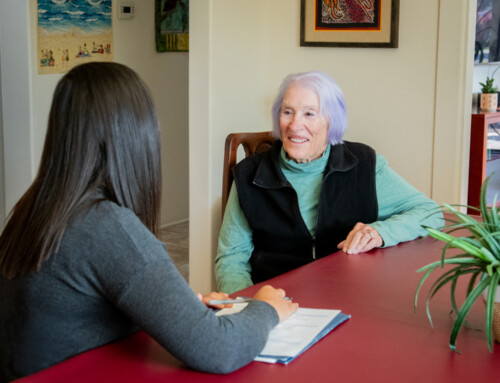 Communication can be challenging in even the best of circumstances. When you throw Alzheimer’s or another form of dementia into the mix, it’s easy for both care partners and the person living with the disease to become frustrated. Keep reading to learn some strategies for successful communication.
Communication can be challenging in even the best of circumstances. When you throw Alzheimer’s or another form of dementia into the mix, it’s easy for both care partners and the person living with the disease to become frustrated. Keep reading to learn some strategies for successful communication.
What is dementia?
Let’s start with the basics. Dementia is a progressive brain disease in which two or more of the following functions are significantly impaired:
- Memory: short-term or long-term
- Cognition: thinking, planning, reasoning, and language skills
- Behavior: changes to mood or personality
- Physical function: motor skills, balance and gait, and the senses
It’s important to keep in mind that dementia is a disease. For a person with dementia, their disability is memory loss. You wouldn’t ask a blind person to see – don’t ask someone with dementia to remember. As a caregiver, you can’t control memory loss – only your reaction to it.
Common communication challenges for someone living with dementia:
- Finding the right words and understanding their meaning
- Connecting what is seen with what is heard
- Paying attention
- Filtering out background noise
- Frustration when communication isn’t working
- Repetition of statements or questions
Communication techniques for care partners:
- Forgive: Move past negative reactions and accept blame (even when it isn’t your fault). Don’t take things personally, question their memory, or blame them.
- Slow down: Adjust your expectations, and be willing to try again later. Stay cheerful and reassuring. Don’t rush.
- Keep it simple: Provide brief explanations, repeat instructions or sentences in exactly the same way, and present the person with easy, straightforward options. Try to avoid open-ended questions, and don’t remind someone they forgot or try to test their memory.
- Go with the flow: Agree, acknowledge the person’s feelings, and divert or redirect their attention. Don’t reason, argue, or try to convince.
Understanding Anosognosia:
This funny word is important to grasp. Anosognosia is a deficit of self-awareness, a condition in which a person who suffers some disability seems unaware of the existence of their disability. Many people living with dementia are not aware of their own memory loss or changing abilities. It’s not helpful to try to convince someone that they forgot.
Real-world examples:
- “What doctor’s appointment? There’s nothing wrong with me.”
Focus on short explanations & accepting blame: “It’s just a regular check up. I’m sorry I forgot to tell you.”
Avoid reasoning: “You’ve been seeing this doctor every three months for the last two years. It’s written on the calendar and I told you about it yesterday and this morning.” - “I didn’t write this check for $500. Someone at the bank is forging my signature.”
Focus on responding to feelings, reassuring & redirecting: “That’s a scary thought. I’ll make sure they don’t do that. Would you help me fold the towels?”
Avoid arguing: “What? Don’t be silly! The bank wouldn’t be forging your signature.” - “Nobody’s going to make decisions for me. You can go now…and don’t come back!”
Focus on accepting blame, responding to feelings, reassuring & distracting: “I’m sorry this is a tough time. I love you and we’re going to get through this together. You know what? Don has a new job. He’s really excited about it.”
Avoid confronting: “I’m not going anywhere and you can’t remember enough to make your own decisions.” - “Who are you? Where is my husband?”
Focus on going with the flow & reassuring: “He’ll be here for dinner. How about some milk and cookies?”
Avoid taking it personally: “What do you mean ‘where’s your husband?’ I’m right here!” - “I don’t want to eat this! I hate chicken!”
Focus on accepting blame & responding positively: “I’m so sorry, I forgot. I was in such a rush that it slipped my mind. Let me see what else we have available.” Leave the room and try again.
Avoid responding negatively: “You told me you wanted chicken. I’m not making anything else, so you better eat it!” - “I’m going to the store for a newspaper.”
Focus on repeating in the exact same way: “Please put your shoes on…please put your shoes on.”
Avoid repeating differently: “Please put your shoes on…you need to put on your shoes.”
You can also find ways to communicate without words. Try connecting with your person by using the five senses:
- Sight: Pictures can activate old memories, or provide comfort and enjoyment for someone missing a loved one.
- Sound: Music is a powerful way to connect with someone with memory loss.
- Touch: A gentle touch on the shoulder allows a person with memory loss to know you are speaking with them, and can foster a sense of connection.
- Smell: Certain scents can be comforting, especially if they are tied to fond memories. Think flowers, a relaxing fragrance, or a fresh batch of cookies.
- Taste: A person’s favorite treat can be a great distraction on a tough day.
To download this article in Tip Sheet form, click here.
For free support, and for other tip sheets like this one, contact Alzheimer’s San Diego at 858.492.4400




